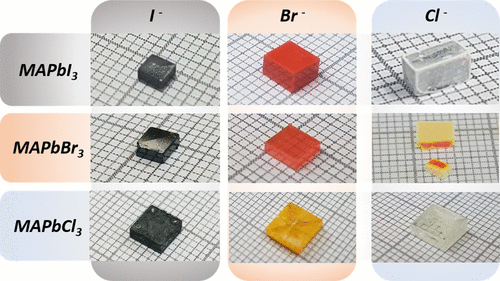当前位置:
X-MOL 学术
›
Chem. Mater.
›
论文详情
Our official English website, www.x-mol.net, welcomes your
feedback! (Note: you will need to create a separate account there.)
Halide Diffusion in MAPbX3: Limits to Topotaxy for Halide Exchange in Perovskites
Chemistry of Materials ( IF 7.2 ) Pub Date : 2020-04-20 , DOI: 10.1021/acs.chemmater.0c00496 Aya Osherov 1 , Yishay Feldman 2 , Ifat Kaplan-Ashiri 2 , David Cahen 1 , Gary Hodes 1
Chemistry of Materials ( IF 7.2 ) Pub Date : 2020-04-20 , DOI: 10.1021/acs.chemmater.0c00496 Aya Osherov 1 , Yishay Feldman 2 , Ifat Kaplan-Ashiri 2 , David Cahen 1 , Gary Hodes 1
Affiliation

|
We study halide exchange in the prototypical halide perovskite, methylammonium lead trihalide, MAPbX3 (X = halide), to test and possibly experimentally use halide diffusion in these materials. We use macroscopic single crystals to study the fundamental exchange process(es) so as to minimize possible grain boundary and surface diffusion effects. Initially, halide exchange creates normal concentration gradients of the outgoing and incoming halides, on a scale of a few microns to a few hundred microns. The depth (from the surface) of the substituted volume depends on the halide pair and on which one is exchanged and which is exchanging. The concentration gradient of the incoming halides decreases from the crystal surface toward its inner core and vice versa for the out-going halides; the profiles roughly fit diffusion in a semi-infinite specimen. This concentration gradient changes slowly with time, with the crystal becoming more homogeneous with storage time. Using the Boltzmann–Matano method and diffusion profiles from electron-dispersive spectroscopy, we evaluate the halide diffusion coefficients; these are not constant and depend on the halide couple. Although these gradients cause a lattice parameter change and may cause a symmetry change, X-ray diffraction shows that if the exchanging halides are of similar size (e.g., Br– and Cl–, Br– and I–, but not Cl– and I–), the resulting material remains single crystalline, prima facie evidence for bulk halide diffusion. These findings are valid, irrespective of which is the exchanged halide. These results suggest that for the similar-sized halide pairs the solid-state chemical exchange is topotactic such that the resulting crystal orientation is determined by that of the initial crystal. I–Cl exchange leads to loss of single crystallinity, suggesting lack of miscibility, a finding that might bear on the difficulty in finding Cl in MAPbI3 samples grown from Cl-containing solutions.
中文翻译:

MAPbX 3中的卤化物扩散:钙钛矿中卤化物交换的拓扑毒性极限
我们研究了原型卤化物钙钛矿,甲基铵三卤化铅,MAPbX 3中的卤化物交换。(X =卤化物),以测试并可能在实验中使用这些材料中的卤化物扩散。我们使用宏观单晶来研究基本的交换过程,从而最大程度地减少可能的晶界和表面扩散效应。最初,卤化物交换会在几微米到几百微米的范围内形成流出和流入的卤化物的正常浓度梯度。取代体积的深度(从表面开始)取决于卤化物对以及交换的对和交换的对。输入的卤化物的浓度梯度从晶体表面朝着其内芯减小,反之亦然。这些轮廓大致适合半无限样本中的扩散。浓度梯度随时间缓慢变化,随着晶体的储存时间变得越来越均匀。使用玻尔兹曼–马塔诺方法和电子色散光谱的扩散曲线,我们评估了卤化物的扩散系数。这些不是恒定的,取决于卤化物对。尽管这些梯度会引起晶格参数的变化并可能导致对称性的变化,但X射线衍射表明,如果交换卤化物的尺寸相似(例如,Br-和Cl - ,溴-和我- ,但不是氯-和我- ),将得到的材料保持单晶,初步散装卤化物扩散证据。这些发现是有效的,与交换的卤化物无关。这些结果表明,对于相似大小的卤化物对,固态化学交换是势能性的,因此最终的晶体取向由初始晶体的取向决定。I–Cl交换导致单结晶度的丧失,表明缺乏混溶性,这一发现可能与在从含Cl溶液中生长的MAPbI 3样品中寻找Cl的困难有关。
更新日期:2020-04-20
中文翻译:

MAPbX 3中的卤化物扩散:钙钛矿中卤化物交换的拓扑毒性极限
我们研究了原型卤化物钙钛矿,甲基铵三卤化铅,MAPbX 3中的卤化物交换。(X =卤化物),以测试并可能在实验中使用这些材料中的卤化物扩散。我们使用宏观单晶来研究基本的交换过程,从而最大程度地减少可能的晶界和表面扩散效应。最初,卤化物交换会在几微米到几百微米的范围内形成流出和流入的卤化物的正常浓度梯度。取代体积的深度(从表面开始)取决于卤化物对以及交换的对和交换的对。输入的卤化物的浓度梯度从晶体表面朝着其内芯减小,反之亦然。这些轮廓大致适合半无限样本中的扩散。浓度梯度随时间缓慢变化,随着晶体的储存时间变得越来越均匀。使用玻尔兹曼–马塔诺方法和电子色散光谱的扩散曲线,我们评估了卤化物的扩散系数。这些不是恒定的,取决于卤化物对。尽管这些梯度会引起晶格参数的变化并可能导致对称性的变化,但X射线衍射表明,如果交换卤化物的尺寸相似(例如,Br-和Cl - ,溴-和我- ,但不是氯-和我- ),将得到的材料保持单晶,初步散装卤化物扩散证据。这些发现是有效的,与交换的卤化物无关。这些结果表明,对于相似大小的卤化物对,固态化学交换是势能性的,因此最终的晶体取向由初始晶体的取向决定。I–Cl交换导致单结晶度的丧失,表明缺乏混溶性,这一发现可能与在从含Cl溶液中生长的MAPbI 3样品中寻找Cl的困难有关。

































 京公网安备 11010802027423号
京公网安备 11010802027423号